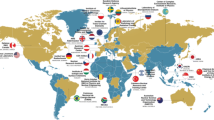Abstract
The Nuclear Forensics International Technical Working Group (ITWG) recently completed its fourth Collaborative Materials Exercise (CMX-4) in the 21 year history of the Group. This was also the largest materials exercise to date, with participating laboratories from 16 countries or international organizations. Exercise samples (including three separate samples of low enriched uranium oxide) were shipped as part of an illicit trafficking scenario, for which each laboratory was asked to conduct nuclear forensic analyses in support of a fictitious criminal investigation. In all, over 30 analytical techniques were applied to characterize exercise materials, for which ten of those techniques were applied to ITWG exercises for the first time. An objective review of the state of practice and emerging application of analytical techniques of nuclear forensic analysis based upon the outcome of this most recent exercise is provided.












Similar content being viewed by others
Notes
While not specifically an “elemental” analysis technique, IC was generally grouped into this category for discussion purposes.
References
IAEA (2015) IAEA Nuclear Security Series #2-G, Rev.1. Nuclear Forensics in Support of Investigations, Vienna
Koch L, Niemeyer S (1996) A report on recent international progress for enhancing nuclear forensic capabilities for cases of illicit nuclear materials, pp. 1–26, IAEA-CN-86-67
Borgardt JD, Wong FMG (2014) Galaxy Serpent: A Web-based Tabletop Exercise Using the Concept of National Nuclear Forensics Libraries. J Nucl Mater Manag 42:4
Hanlen RC, Schwantes JM (2011) ITWG Round Robin #3 Exercise Results. In: the 52nd annual meeting of the Institute for Nuclear Materials Management (INMM), Palm Desert, CA, July 18, 2011. PNNL-SA-80917
Hanlen R (2014) Nuclear Forensics International Technical Working Group, 4th Collaborative Materials Exercise, Exercise Plan, Richland, WA, PNNL-SA-102470
Schwantes JM, Marsden O (2014) Nuclear Forensics International Technical Working Group (ITWG) 4th Collaborative Materials Exercise (CMX-4) exercise plan. Pacific Northwest National Laboratory, PNNL-SA-102470
Joint Committee of Guides for Metrology (2008) Evaluation of measurement data—guide to the expression of uncertainty in measurement, JCGM-100, 1st ed, September
Schneider CA, Rasband WS, Eliceiri KW (2012) NIH Image to ImageJ: 25 years of image analysis. Nat Methods 9:671–675
Author information
Authors and Affiliations
Corresponding author
Additional information
Jon M. Schwantes and Oliva Marsden are the Co-chairs of the Exercise Task Group of the Nuclear Forensics International Technical Working Group.
Rights and permissions
About this article
Cite this article
Schwantes, J.M., Marsden, O. & Pellegrini, K.L. State of practice and emerging application of analytical techniques of nuclear forensic analysis: highlights from the 4th Collaborative Materials Exercise of the Nuclear Forensics International Technical Working Group (ITWG). J Radioanal Nucl Chem 311, 1441–1452 (2017). https://doi.org/10.1007/s10967-016-5037-5
Received:
Published:
Issue Date:
DOI: https://doi.org/10.1007/s10967-016-5037-5




